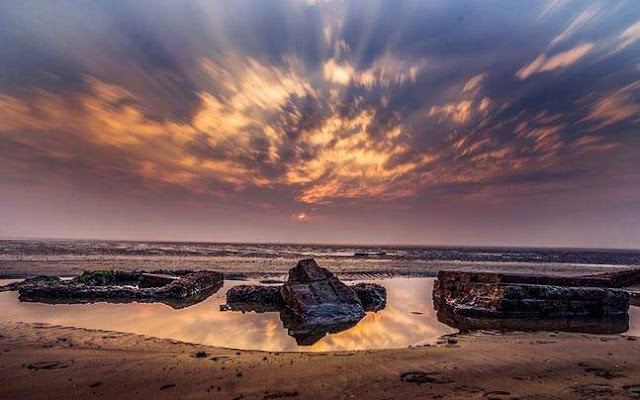Lonar is one of Maharashtra’s
best-kept secrets. Lonar Lake is incredibly 50,000 years old lake. Lonar Lake
is also called Lonar Crater is the youngest and best preserved impact crater
formed in basalt rock and is the only of its kind on earth. The crater was
formed fifty-two thousand years ago, when a gigantic meteor crashed into the
earth at an estimated speed of 90,000 km per hour. Lonar Crater has a mean
diameter of 3,900 ft and is about 449 ft below the crater rim, and meteor
crater rim is about 1.8 KM in diameter.
The Lake is mainly fed by Dhara
and Sita Nahani streams. The Lonar Crater is protected as a geological landmark
and authorities have recognized the role of the historical and archaeological
heritage in the lake. The lake water contains various salts or sodas, and
during dry weather when evaporation lessens the water level, large quantities
of soda are collected. The Lonar crater has an oval shape and its meteorite
impact came from the east, at an angle of 35 to 40 degrees. The saline deposits
obtained from the lake are rather of an exceptional nature.
The salts collected from this
lake vary in their nature and composition and from their-appearance are effortlessly
separated by men accustomed to handling them. The Lonar Lake is home to a horde
of algae and plankton species that thrive in its unusual ecosystem and give the
water its vibrant color. Most tourists come to nearby Aurangabad to visit the
Ajanta and Ellora UNESCO World Heritage Sites, but never make it as far as
Lonar.
Over time, the jungle took over
the deep depression, and a perennial stream transformed the crater into a
tranquil, emerald green lake. Today, the forest-fringed lake is located in
the Buldhana District of Maharashtra. The lake was initially believed to be of
volcanic origin, but now it is recognized as an impact crater created by the
hypervelocity impact of either a comet or an asteroid. The lake water is polluted by using of
fertilizers, pesticides and toxic material in the agricultural field.
The lake has wildlife sanctuary
with a unique ecology that is vastly different from the surrounding flat
landscape. Its water supports micro-organisms rarely found elsewhere on earth
while its surroundings are peppered with fragments of unique minerals like
maskelynite. The local peoples are destroying Lake Eco system, by bathing,
washing clothes and drinking water by cattle’s and disposing detergents in
them. Deforestation and excavation also carried out here and cattle grazing
inside near him create fecal pollution cause environmental damage to nearby
land.
Marauding pilgrims and increasing
pollution is disturbing its substantial flora and fauna with about 100 resident
and migratory birds. Furthermore lonar lake ecosystem is being damaged because
of the sewage dump in the lake. Also commercial activities, including illegal
construction, within the vicinity of lake has damaged the lake's natural
topography. There is a small circular depression at a distance of around 700m
from the main lake, believed to be caused by a splinter of the meteor that hit
the ground to also make a crater.
The Lonar Lake is also home to
thousands of peafowls, chinkara and gazelles. The natural lake is a heaven for
a many species of plant and animal life. The migratory and resident birds such
as black-winged stilts, grebes, shelducks, shovellers, teals, herons, red-wattled
lapwings, blue jays, baya weavers, parakeet hoopoes, larks, tailorbirds,
magpies, robins and swallows are found on the lake. Also among reptiles, the
monitor lizard is reported to be the most prominent. Lonar Lake is one of the
most exclusive landmarks on the world. Hence, it is slightly out of the way,
but totally worth it.
Before you go there, keep in mind
that March till May are the hottest months in Maharashtra, and temperatures can
climb upwards of 40°C. Occasional. However monsoons normally starts in June and
can go on up to September. The heavy rainfall took place in July. Hence, winter
starts from Oct till Feb is mild, with clear skies, gentle breezes and average
daytime temperatures that range between 12-25°C. The views of this stunning
Crater Lake, the only one of its kind in the world, are bound to give wings to
your imagination.

















































